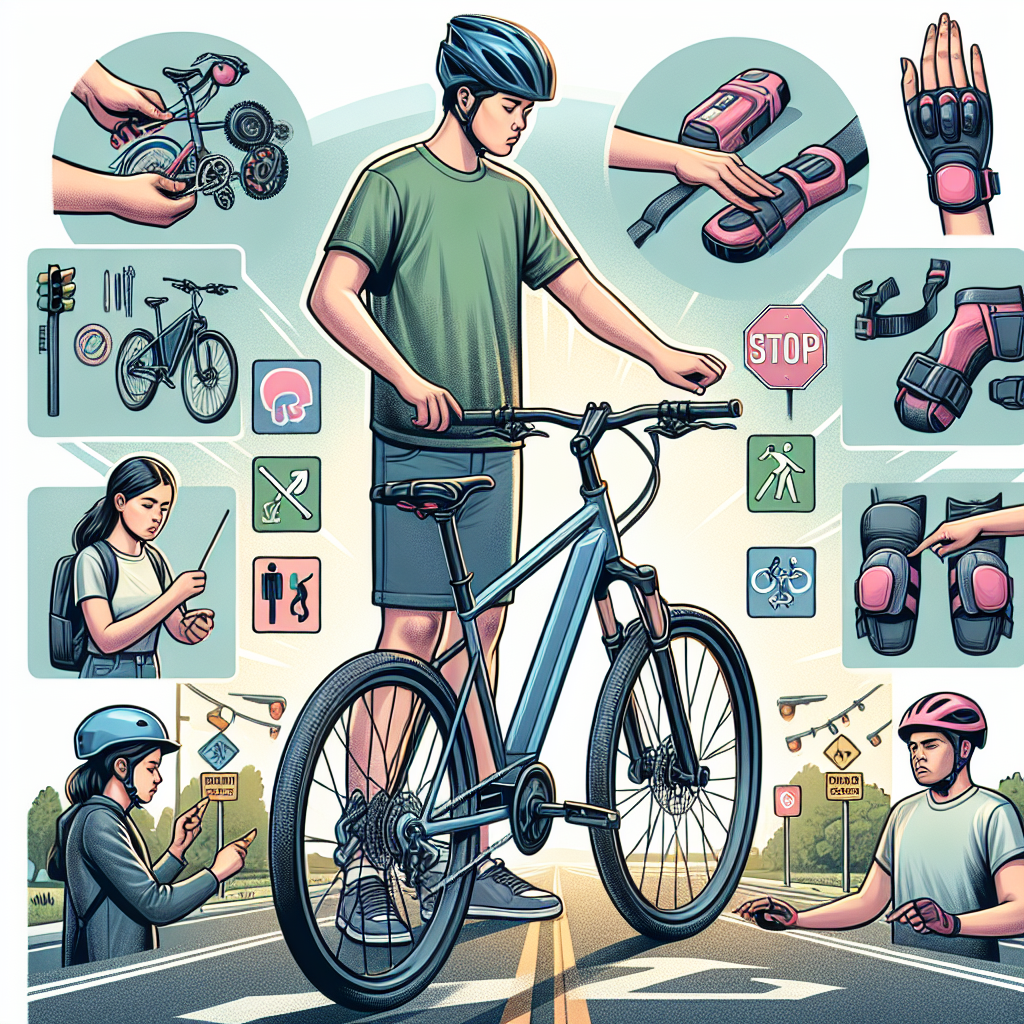Whether you’re a complete beginner or have some experience with ebikes, safety should always be your top priority. In this article, we will provide you with some essential safety tips to ensure you have a safe and enjoyable riding experience on your ebike. From wearing the right protective gear to understanding the rules of the road, these tips will help you ride confidently and stay safe while exploring the world on your new electric bike. So, strap on your helmet, hop on your ebike, and let’s get started on this exciting journey towards becoming a responsible and vigilant ebiker.

Choosing the Right E-bike
When it comes to choosing the right e-bike for you, it’s important to consider your experience level. If you’re new to riding an e-bike, you may want to start with a more beginner-friendly option. These bikes typically have lower power output and are easier to handle, making them ideal for those who are just getting started.
Researching different types of e-bikes is also crucial in making the right choice. There are various types available, such as mountain e-bikes, city e-bikes, and folding e-bikes, each designed for different purposes. Determine the type of terrain and the distance you plan to cover, as this will help you narrow down your options.
Another factor to consider is the appropriate size and fit of the e-bike. This is essential for your comfort and safety while riding. Take the time to test out different models and consult the manufacturer’s sizing guide to ensure you choose the right frame size and adjust the seat height accordingly. A properly fitted e-bike will make your riding experience much more enjoyable.
Understanding Local Laws and Regulations
Before setting out on your e-bike adventures, it’s crucial to understand the local laws and regulations surrounding e-bike usage. This will help you stay safe and avoid any legal issues that may arise.
Know the speed limits and bike lane rules in your area. Some jurisdictions have specific speed limits for e-bikes, while others may require riders to adhere to regular bicycle speed limits. Familiarize yourself with these regulations to ensure you’re riding within the legal limits.
In addition to knowing the speed limits, it’s essential to understand the helmet laws in your area. While helmet laws vary by location, it’s always a good idea to wear a helmet for your own protection. Even if it’s not required by law, a helmet can significantly reduce the risk of head injuries in case of an accident.
Furthermore, it’s crucial to understand e-bike classification and requirements. Different regions may have different classifications for e-bikes based on factors such as maximum power output and top speed. Knowing which category your e-bike falls into will help you determine if any specific requirements, such as registration or licensing, apply to your situation.
Wearing Appropriate Safety Gear
When riding an e-bike, always wear a helmet. It serves as your first line of defense against head injuries in case of a fall or collision. Choose a helmet that is certified and meets safety standards to ensure maximum protection. Make sure it fits properly and is securely fastened before you start your ride.
Investing in protective gloves is also a wise choice. Not only do they provide an extra layer of protection for your hands, but they also offer added grip and control while riding. Look for gloves specifically designed for cycling, as these will provide the best combination of comfort and safety.
For additional protection, especially if you’re planning to ride off-road or engage in more extreme activities, consider wearing knee and elbow pads. These pads can help prevent serious injuries in case of spills or accidents. They provide a cushioning effect and absorb the impact, reducing the risk of fractures or lacerations.

Getting Comfortable with the Controls
Before hitting the road, it’s essential to get comfortable with the controls of your e-bike. This will ensure that you can confidently navigate and ride safely in various situations.
Start by learning how to properly start and stop the e-bike. Familiarize yourself with the power button or key and understand the process of turning the bike on and off. Practice starting and stopping in a safe and open area until you feel confident in your abilities.
Once you’re comfortable with starting and stopping, it’s time to practice using the throttle and pedal-assist modes. The throttle allows you to control the speed of the e-bike without pedaling, while the pedal-assist mode provides assistance when you pedal. Experiment with different settings and find a balance that suits your riding style and comfort level.
Understanding the braking system is also crucial for your safety. E-bikes may have different types of brakes, such as disc brakes or rim brakes. Familiarize yourself with the location and function of the brakes on your specific model. Practice braking in various situations to get a feel for their responsiveness and ensure you can control your speed effectively.
Riding Techniques and Etiquette
Maintaining a proper riding posture is vital for both safety and comfort. Keep your back straight, shoulders relaxed, and hands firmly on the handlebars. This posture will help you maintain control and balance while riding. Avoid slouching or leaning too far forward, as this can negatively affect your ability to control the e-bike.
Observe all traffic rules and signals while riding. As an e-bike rider, you’re sharing the road with other vehicles, cyclists, and pedestrians. Adhere to traffic laws, including obeying traffic signals, yielding right-of-way, and staying in designated bike lanes when available. Being a responsible rider not only ensures your safety but also fosters positive relationships with other road users.
Signal your intentions to other road users. Use hand signals to indicate turns, lane changes, and stops. Signaling helps to communicate your intentions and allows others to anticipate your actions, reducing the risk of accidents. Practice using these signals until they become second nature, and always use them when riding in traffic.
Being Aware of Surroundings
When riding an e-bike, it’s important to stay focused and avoid distractions. Put away your phone and any other devices that may divert your attention. Maintaining focus on the road and your surroundings will help you react quickly to potential hazards and ensure a safe riding experience.
Regularly scan the road for potential hazards. Look out for obstacles, such as potholes, debris, or uneven surfaces, that may pose a threat to your safety. Be aware of other road users, including vehicles, pedestrians, and other cyclists. Anticipate their movements and adjust your riding accordingly.
Use rearview mirrors or look over your shoulder to check for vehicles approaching from behind. Being aware of your surroundings at all times is crucial for your safety, as it allows you to make informed decisions and take appropriate actions to avoid potential accidents.
Maintaining Safe Speed and Distance
Don’t exceed the recommended speed limit for your e-bike. Each e-bike model has a maximum speed recommended by the manufacturer. Going beyond this speed can compromise your safety and control over the bike. It’s important to ride at a speed that is comfortable for you and allows you to react to any unexpected situations or obstacles.
Keep a safe distance from other vehicles while riding. This gives you ample time to react and maneuver if necessary. Leave enough space between you and the vehicle in front of you to allow for sudden stops or changes in traffic flow. It’s better to have a bit of extra distance for your safety.
Adjust your speed based on road conditions. Factors such as weather, road surface, and traffic density can influence your riding experience. Reduce your speed in adverse conditions, such as rain, snow, or low visibility, to maintain control over your e-bike. Always prioritize safety over speed.
Battery and Charging Safety
Follow the manufacturer’s guidelines for charging your e-bike’s battery. Overcharging can damage the battery and shorten its lifespan. Be mindful of the recommended charging time and avoid leaving the battery plugged in for extended periods when it’s fully charged. Following these guidelines will help maintain the battery’s performance and ensure its longevity.
Inspect the battery and connections regularly. Look for any signs of damage or wear, such as cracks or frayed wires. If you notice any issues, consult the manufacturer or a professional technician to address the problem promptly. Regular inspections can help identify potential problems before they become severe safety hazards.
Avoid overcharging or leaving the battery unattended for long periods. When charging your e-bike’s battery, be present and attentive to ensure that no issues arise during the charging process. Unplug the charger once the battery is fully charged and store it in a safe and dry location.
Routine Maintenance and Inspections
Perform regular maintenance and inspections on your e-bike to keep it in safe working condition. Check the tire pressure and tread regularly. Proper tire pressure ensures optimal performance and control, while adequate tread provides better traction. Adjust the tire pressure as recommended by the manufacturer and replace tires with worn-out tread.
Inspect the brakes and lights for proper functionality. The brakes should engage smoothly and bring the bike to a complete stop without any issues. Ensure that both the front and rear lights are functioning correctly, as they are essential for visibility, especially in low-light conditions. Replace any faulty components or seek professional assistance if necessary.
Keep the bike clean and lubricate moving parts regularly. Dirt and debris can accumulate on your e-bike and affect its performance. Clean the frame, gears, and chain regularly using a mild detergent and water. Apply lubricant to the chain and other moving parts to reduce friction and ensure smooth operation.
Staying Visible and Using Lights
To enhance your visibility on the road, use bright front and rear lights on your e-bike. These lights help other road users spot you from a distance and make you more visible, especially during low-light conditions or at night. Ensure that the lights are properly mounted and in good working order before each ride.
Consider adding reflective stickers or clothing to your e-bike attire. Reflective materials significantly increase your visibility, especially when headlights illuminate them. Reflective stickers can be applied to various parts of your e-bike, such as the frame or rims. Additionally, wearing reflective clothing or accessories further enhances your visibility and safety.
Don’t forget to turn on your lights even during daylight. It may seem unnecessary, but using your lights during the day makes you more visible to other road users. This is particularly important in areas with heavy traffic or when riding in adverse weather conditions. By turning on your lights, you’re taking an extra step to ensure your safety on the road.
By following these e-bike safety tips for beginners, you can enjoy a safe and enjoyable riding experience. Always prioritize your safety, adhere to local laws and regulations, and take the necessary precautions to protect yourself and those around you. With proper understanding and preparation, you can confidently navigate the roads and trails with your e-bike. Happy riding!

